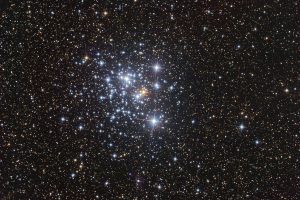Many millions of stars live in groups called “star clusters”. As stars form in a nebula it is not uncommon for them to cluster together, bound by gravitational forces. As the stars continue to develop the cluster may dissipate. There are two types: open clusters and globular clusters.
Open cluster
An open cluster is a loosely bound aggregate of young stars that are gradually scattering. Usually the region of new star creation, open clusters are formed from a common nebula of clouds and dust and, as a consequence, have the same chemical composition. Accretion of materials is random, so it is expected that open cluster stars vary enormously in terms of mass. Though the Milky Way has more than 1 100 open star clusters they only account for about 1% of the total population of stars. This is because star clusters, by their turbulent nature, are forever shedding stars over hundreds of millions of years, populating the galaxy mainly as binaries or as multiple star systems.

About half of the clusters contain fewer than 100 stars. Open clusters are asymmetrical and range in size from 5 light years to 75 light years across.
The following are some examples of notable open clusters.
Hyades is one of the closest open clusters to Earth, at 150 light years, and one of the few visible to the naked eye. It lies in the constellation Taurus. In front of Hyades, closer at 90 light years is the red giant Aldebaran.
Pleiades is between 434 and 446 light years away as determined by Nasa’s Jet Propulsion Laboratory. It is also known as the Seven Sisters and is the best-known open cluster in the sky. It lies in the constellation Taurus and is easily visible to the naked eye. The cluster is 100 million years old and will only survive for another 250 million years. The stars in this cluster are blue giants of class B and are hotter and more luminous than the sun. Most gas and clouds associated with a cluster are material associated with star formation. But in the case of this cluster the cloud is moving through Pleiades at 40 000 kilometres an hour and will eventually continue on into deep space.
The Butterfly Cluster is 2 000 light years away. It is about 100 million years old, lies close to the centre of the Milky Way, and is about 12 light years in diameter. Most of the stars that make up this cluster are hot blue main sequence stars. The brightest member, however, is an orange supergiant, an irregular variable called BM Scorpii.
The Jewel Box, also known as Kappa Crucis Cluster, contains about 200 stars. It is 20 light years across and is less than 10 million years old—one of the youngest open clusters known to astronomers. The three brightest are blue giants and the fourth brightest is a red supergiant. The various colours are very distinctive, hence its popular name.
Globular cluster
A globular cluster is a massive group of stars bound together by gravity into a spherical shape often less than 200 light years in diameter. They can contain between 10 000 and several million stars. The members of a globular cluster are formed from the same materials (as with open clusters) so have a common chemical profile. They also share the same age and are at least 10 billion years old. It is probable they formed before the time of our own galaxy.
More than 150 globular clusters have been found in the Milky Way. Most of them do not have names, but bare catalogue numbers. The following are some examples of notable globular clusters.
Omega Centauri is the largest globular cluster in the Milky Way, up to tens times more massive than its nearest relation and contains more than 10 million stars. Indeed this cluster is more massive than some of the smaller galaxies in the universe. It is one of the oldest objects too, almost as old as the universe itself. There is a cogent theory that suggests Omega Centauri was originally a galaxy in its own right but that it collided with the Milky Way and got ripped apart in the process. It is 17 000 light years distant and estimated at 150 light years in diameter.
Another example of a globular cluster lies in the Constellation of Tucana: 47 Tucanae. It is 13 400 light years away. It was originally catalogued as a star. It is the second largest and second brightest globular cluster in the sky. Its central region is so crowded that there are a high rate of collisions, believed to have caused the formation of blue stragglers found in the community.
One of the first globular clusters to be recognised is NGC 6218, actually discovered by Charles Messier in 1764. Under his catalogue system it was labelled M12. It is about 15 700 light years distant in the Constellation Ophiuchus. It is some 70 light years across and is relatively less dense than most clusters.
Back to Top
By Nigel Benetton, science fiction author of Red Moon Burning and The Wild Sands of Rotar.
Last updated: Tuesday, 2nd March 2021